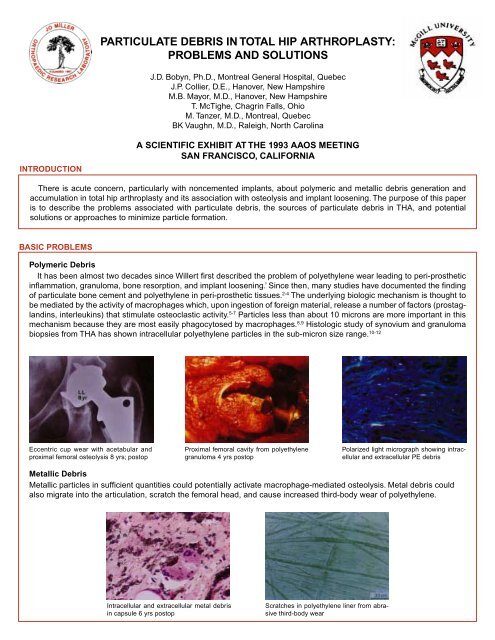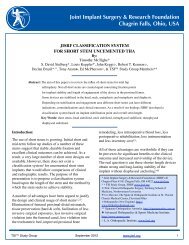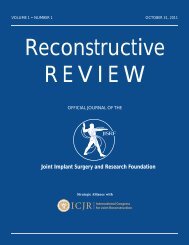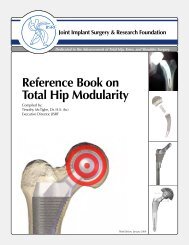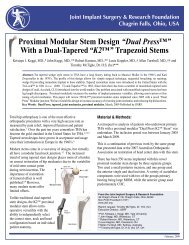Particulate Debris in Total Hip Arthroplasty - Joint Implant Surgery ...
Particulate Debris in Total Hip Arthroplasty - Joint Implant Surgery ...
Particulate Debris in Total Hip Arthroplasty - Joint Implant Surgery ...
You also want an ePaper? Increase the reach of your titles
YUMPU automatically turns print PDFs into web optimized ePapers that Google loves.
PARTICULATE DEBRIS IN TOTAL HIP ARTHROPLASTY:<br />
PROBLEMS AND SOLUTIONS<br />
J.D. Bobyn, Ph.D., Montreal General Hospital, Quebec<br />
J.P. Collier, D.E., Hanover, New Hampshire<br />
M.B. Mayor, M.D., Hanover, New Hampshire<br />
T. McTighe, Chagr<strong>in</strong> Falls, Ohio<br />
M. Tanzer, M.D., Montreal, Quebec<br />
BK Vaughn, M.D., Raleigh, North Carol<strong>in</strong>a<br />
INTRODUCTION<br />
A SCIENTIFIC EXHIBIT AT THE 1993 AAOS MEETING<br />
SAN FRANCISCO, CALIFORNIA<br />
There is acute concern, particularly with noncemented implants, about polymeric and metallic debris generation and<br />
accumulation <strong>in</strong> total hip arthroplasty and its association with osteolysis and implant loosen<strong>in</strong>g. The purpose of this paper<br />
is to describe the problems associated with particulate debris, the sources of particulate debris <strong>in</strong> THA, and potential<br />
solutions or approaches to m<strong>in</strong>imize particle formation.<br />
BASIC PROBLEMS<br />
Polymeric <strong>Debris</strong><br />
It has been almost two decades s<strong>in</strong>ce Willert first described the problem of polyethylene wear lead<strong>in</strong>g to peri-prosthetic<br />
<strong>in</strong>flammation, granuloma, bone resorption, and implant loosen<strong>in</strong>g.’ S<strong>in</strong>ce then, many studies have documented the f<strong>in</strong>d<strong>in</strong>g<br />
of particulate bone cement and polyethylene <strong>in</strong> peri-prosthetic tissues. 2-4 The underly<strong>in</strong>g biologic mechanism is thought to<br />
be mediated by the activity of macrophages which, upon <strong>in</strong>gestion of foreign material, release a number of factors (prostagland<strong>in</strong>s,<br />
<strong>in</strong>terleuk<strong>in</strong>s) that stimulate osteoclastic activity. 5-7 Particles less than about 10 microns are more important <strong>in</strong> this<br />
mechanism because they are most easily phagocytosed by macrophages. 8,9 Histologic study of synovium and granuloma<br />
biopsies from THA has shown <strong>in</strong>tracellular polyethylene particles <strong>in</strong> the sub-micron size range. 10-12<br />
Eccentric cup wear with acetabular and<br />
proximal femoral osteolysis 8 yrs; postop<br />
Proximal femoral cavity from polyethylene<br />
granuloma 4 yrs postop<br />
Polarized light micrograph show<strong>in</strong>g <strong>in</strong>tracellular<br />
and extracellular PE debris<br />
Metallic <strong>Debris</strong><br />
Metallic particles <strong>in</strong> sufficient quantities could potentially activate macrophage-mediated osteolysis. Metal debris could<br />
also migrate <strong>in</strong>to the articulation, scratch the femoral head, and cause <strong>in</strong>creased third-body wear of polyethylene.<br />
Intracellular and extracellular metal debris<br />
<strong>in</strong> capsule 6 yrs postop<br />
Scratches <strong>in</strong> polyethylene l<strong>in</strong>er from abrasive<br />
third-body wear
SOURCES OF POLYETHYLENE DEBRIS<br />
PROBLEM: Wear Related to Polyethylene Quality<br />
In normally wear<strong>in</strong>g artificial jo<strong>in</strong>ts, l<strong>in</strong>ear wear rates of 0.05 to 0.2 mm per year result <strong>in</strong> the generation of about 25 to 100<br />
mm 3 (25 to 100 mg) of polyethylene debris annually. 13-15 On the basis of known dimensions of polyethylene particles found<br />
<strong>in</strong> tissues around hip prostheses, this equates to the annual production of tens to hundreds of billions of particles.<br />
Variations <strong>in</strong> polyethylene wear rates probably relate, at least <strong>in</strong> part, to the quality of the polyethylene used. 15 Wide variations<br />
are known to exist between batches of polyethylene and between different polyethylene suppliers.<br />
SOLUTION:<br />
Use ultra high molecular weight polyethylene (UHMWPE) with<br />
high rat<strong>in</strong>gs <strong>in</strong> key mechanical and physical properties (Table<br />
1). Use UHMWPE with a consistently high level of quality<br />
control over parameters such as start<strong>in</strong>g powder composition,<br />
extrusion process<strong>in</strong>g (extruded rod generally results <strong>in</strong><br />
better consolidation and improved properties compared with<br />
compression molded UHMWPE sheets), post-extrusion anneal<strong>in</strong>g<br />
(to <strong>in</strong>crease crystall<strong>in</strong>ity and dimensional stability),<br />
ultrasound <strong>in</strong>spection for voids and <strong>in</strong>clusions, oxidation, and<br />
mechanical properties. In general, polyethylene that exceeds<br />
m<strong>in</strong>imum ASTM standards is available from several implant<br />
manufacturers (Table 1).<br />
Table 1. Properties of UHMWPE<br />
ASTM Commercially Commercially<br />
Standard Available PE 16 Available PE 17<br />
Molecular Weight 3 x 10 6 5 x 10 6 ––<br />
Ultimate Tensile 4000 PSI 6700 PSI 6000 PSI<br />
Strength<br />
Tensile Yield 2800 PSI 3300 PSI 4100 PSI<br />
Izod Impact 20 FT-LB No Break No Break<br />
Hardness 60 Shore D 69 Shore D 65 Shore D<br />
Elongation to Failure 200% 350% 330%<br />
PROBLEM: Polyethylene Wear Related to Modular Acetabular <strong>Implant</strong>s<br />
Additional sources of polyethylene wear can result from the use of modular (2-piece) acetabular implants.”-” These <strong>in</strong>clude:<br />
Polyethylene l<strong>in</strong>er/metal<br />
back motion - related to<br />
mechanical <strong>in</strong>tegrity of<br />
the lock<strong>in</strong>g mechanism<br />
Incomplete conformity of<br />
l<strong>in</strong>er with metal back can<br />
result <strong>in</strong> cold flow, plastic<br />
deformation, <strong>in</strong>creased<br />
stress, <strong>in</strong>creased<br />
wear<br />
Th<strong>in</strong> polyethylene result<strong>in</strong>g<br />
from modular design<br />
can cause higher stress,<br />
<strong>in</strong>creased wear, l<strong>in</strong>er fracture<br />
Abrasion of screw<br />
heads aga<strong>in</strong>st the convex<br />
polyethylene surface<br />
L<strong>in</strong>er fracture 4 yrs postop, head wear of<br />
cup metal back<strong>in</strong>g, tissue metallosis<br />
SOLUTIONS:<br />
• Use non-modular acetabular components<br />
• Use modular acetabular components with:<br />
- high degree of l<strong>in</strong>er/metal back conformity and support (with<br />
smooth concave metal surface to m<strong>in</strong>imize abrasive wear)<br />
- highly secure l<strong>in</strong>er/metal back lock<strong>in</strong>g mechanism<br />
- m<strong>in</strong>imum polyethylene thickness of 6 to 8 MM 22,23
PROBLEM: Polyethylene Wear Related to Femoral Head Size<br />
Cl<strong>in</strong>ical evidence <strong>in</strong>dicates that the use of 32 mm heads <strong>in</strong> THA <strong>in</strong>creases the volumetric<br />
wear. This problem is accentuated with cups possess<strong>in</strong>g relatively th<strong>in</strong> polyethylene,<br />
as occurs with smaller size modular prostheses.<br />
SOLUTION:<br />
A recent cl<strong>in</strong>ical study by Livermore et al <strong>in</strong>dicated that a 28 mm head size was preferred<br />
for optimization of both l<strong>in</strong>ear and volumetric wear. 24 Choos<strong>in</strong>g head size to<br />
maximize polyethylene thickness is a priority. The recommendation is to use 26 mm or<br />
28 mm heads more often, although 32 mm heads are still appropriate with larger cups<br />
hav<strong>in</strong>g thick polyethylene.<br />
PROBLEM: Polyethylene Wear Related To Femoral Head Material<br />
Polyethylene wear is generally <strong>in</strong>creased with the use of femoral heads made of titanium alloy because of its lower hardness<br />
and abrasion resistance. Problems with osteolysis due to excessive head and cup wear have been reported with<br />
titanium bear<strong>in</strong>g surfaces. 25-27<br />
SOLUTIONS:<br />
• Do not use titanium alloy femoral heads<br />
• Use titanium alloy femoral heads with improved wear characteristics. This can be accomplished by shallow implantation<br />
of nitrogen or oxygen <strong>in</strong>to the surface or chemical deposition of a harder bear<strong>in</strong>g surface such as titanium nitride.<br />
• A preferred option is to use femoral heads made of cobalt-chrome because of its superior wear characteristics.<br />
• Laboratory evidence supports the use of femoral heads made from ceramic materials, alum<strong>in</strong>a or zirconia oxide, for<br />
reduced polyethylene wear. Prelim<strong>in</strong>ary cl<strong>in</strong>ical evidence from Europe and Japan suggests a reduced wear rate <strong>in</strong> patients<br />
but the data are not yet def<strong>in</strong>itive. 30-33 At the very least, ceramic bear<strong>in</strong>g materials are more resistant to scratch<strong>in</strong>g<br />
from third bodies such as PMMA or metallic debris from frett<strong>in</strong>g, corrosion, or loosened fragments of porous coat<strong>in</strong>g.<br />
• Based on favorable cl<strong>in</strong>ical trials <strong>in</strong> Europe dur<strong>in</strong>g the past decade, improved ceramic-on-ceramic and metal-on-metal<br />
bear<strong>in</strong>g comb<strong>in</strong>ations have been renewed as possible solutions to the problem of polyethylene wear. 34 Further research<br />
and development <strong>in</strong> this area will be required to establish reliability and efficacy.<br />
SOURCES OF METALLIC DEBRIS<br />
PROBLEM: Frett<strong>in</strong>g Wear of Metallic <strong>Implant</strong><br />
Components<br />
Frett<strong>in</strong>g wear of mechanically jo<strong>in</strong>ed metallic implant<br />
components is <strong>in</strong>evitable given sufficient load<br />
and number of load cycles. 35-38 Thus, all modular<br />
implant junctions are prone to frett<strong>in</strong>g and the generation<br />
of metallic debris. This <strong>in</strong>cludes:<br />
• Junctions between screws and metal back<strong>in</strong>g<br />
of modular cups<br />
• Head/neck taper junctions<br />
• Other stem modular junctions utiliz<strong>in</strong>g lock<strong>in</strong>g<br />
mechanisms such as tapers or dovetails to connect<br />
sleeves, pads, or stem segments.<br />
SOLUTIONS<br />
• M<strong>in</strong>imize the number of modular junctions (e.g.,<br />
use cups without screw holes or reduce use of<br />
screws for acetabular cup fixation)<br />
• Use modular junctions with secure lock<strong>in</strong>g<br />
mechanisms, high quality fabrication tolerances,<br />
surface f<strong>in</strong>ishes that reduce debris generation,<br />
and proven mechanical safety <strong>in</strong> laboratory test<strong>in</strong>g.<br />
Frett<strong>in</strong>g marks on Ti-6AI-4V taper 4 yrs<br />
postop<br />
Small areas of frett<strong>in</strong>g on modular<br />
stem taper 6 yrs postop<br />
Scann<strong>in</strong>g electron micrograph of frett<strong>in</strong>g<br />
marks on Ti-6AI-4V taper<br />
Scann<strong>in</strong>g electron micrograph of frett<strong>in</strong>g<br />
scars on modular stem taper
PROBLEM: Corrosion at Head/Neck Taper<br />
Junctions<br />
Recent analysis of retrieved femoral implants used<br />
<strong>in</strong> THA has revealed that corrosion sometimes<br />
occurs at the modular head/neck junction. 39-41<br />
Corrosion <strong>in</strong> vary<strong>in</strong>g degrees has been reported<br />
both with dissimilar (Co-Cr head/Ti alloy neck) and<br />
similar (Co-Cr head/Co-Cr neck) metal comb<strong>in</strong>ations.<br />
The corrosion problem has not been the<br />
cause of cl<strong>in</strong>ical failure except <strong>in</strong> a few rare cases<br />
with Co-Cr/Co-Cr tapers that have fractured. Galvanic<br />
corrosion, crevice corrosion, and frett<strong>in</strong>g<br />
corrosion have all been suggested as mechanisms<br />
that are responsible for this problem. 39-43<br />
Corrosion on mixed-metal taper 22 months<br />
postop<br />
Corrosion on Co-Cr/Co-Cr taper 10 yrs<br />
postop<br />
SEM show<strong>in</strong>g <strong>in</strong>tergranular corrosion and<br />
gra<strong>in</strong> loss with a Co-Cr taper 10 yrs postop<br />
SOLUTIONS:<br />
For head/neck tapers with dissimilar metals, the risk of corrosion can be reduced by<br />
us<strong>in</strong>g tapers with tight manufactur<strong>in</strong>g tolerances. This reduces fluid <strong>in</strong>gress and the<br />
extent of frett<strong>in</strong>g which could trigger corrosion by depassivat<strong>in</strong>g the protective metallic<br />
oxide layers and sett<strong>in</strong>g up a crevice corrosion cell. 37,42,43 In response to the corrosion<br />
problem, the orthopaedic implant <strong>in</strong>dustry is improv<strong>in</strong>g the tolerances and quality control<br />
of head/neck tapers.<br />
• For all modular tapers, lock the femoral head onto the neck with adequate force. It<br />
is helpful to <strong>in</strong>itially twist the femoral head <strong>in</strong>to position and then apply 3 or 4 seat<strong>in</strong>g<br />
taps. Ensure that both male and female surfaces are clean and dry prior to assembly.<br />
• For tapers on Co-Cr stems, <strong>in</strong> addition to high quality manufactur<strong>in</strong>g, ensure that heat treatments used to apply porous<br />
coat<strong>in</strong>gs do not create <strong>in</strong>tergranular zones that are prone to corrosive attack and eventual mechanical failure. 44<br />
Metal-sta<strong>in</strong>ed acetabulurn after removal of<br />
loose Ti-6AI-4V cup<br />
Scann<strong>in</strong>g electron micrograph of bead<br />
blasted Ti-6AI-4V implant<br />
PROBLEM: <strong>Particulate</strong> Release Through<br />
<strong>Implant</strong> Bone-Abrasion<br />
Noncemented implants which move relative to the<br />
implant site can release particulate debris through<br />
simple abrasion mechanisms. This problem is<br />
worse with Ti-based implants because of lower<br />
hardness and abrasion resistance. 45 Furthermore,<br />
cosmetic implant preparation techniques such as<br />
bead blast<strong>in</strong>g tend to leave residual contam<strong>in</strong>ants<br />
(silica or alum<strong>in</strong>a) and create tenuous surface irregularities<br />
-these are prone to be<strong>in</strong>g dislodged<br />
by abrasion aga<strong>in</strong>st bone.<br />
SOLUTIONS:<br />
• Increase the surface hardness and abras 0 n<br />
resistance of Ti-based implants through creat!on<br />
of a surface-rich zone of nitrogen or oxygen.<br />
• Increase the cleanl<strong>in</strong>ess and smoothness of<br />
implant surfaces by avoid<strong>in</strong>g grit-blast<strong>in</strong>g or sandblast<strong>in</strong>g.<br />
Instead, leave the implant surface simply<br />
polished or cleaned and micro-etched with<br />
chemical-mill<strong>in</strong>g techniques. 45-48<br />
• Use noncemented implants with design features<br />
that maximize the opportunities for stability,<br />
thereby m<strong>in</strong>imiz<strong>in</strong>g the risk of <strong>in</strong>terface<br />
micromotion and abrasion.<br />
Reduced wear of nitrided Ti alloy abraded<br />
aga<strong>in</strong>st PMMA & cortical bone (p<strong>in</strong> on disk)<br />
SEM of polished and nitrided Ti alloy to<br />
reduce metallic particulate debris
PROBLEM: Third-Body Wear From Debonded Porous Coat<strong>in</strong>g<br />
There are numerous reports of loosened fragments of porous coat<strong>in</strong>g migrat<strong>in</strong>g <strong>in</strong>to<br />
the jo<strong>in</strong>t space and caus<strong>in</strong>g third-body wear of the bear<strong>in</strong>g surfaces. 49-51 This problem<br />
has also been reported with loosened fragments of hydroxyapatite coat<strong>in</strong>g. 52,53 Excessive<br />
polyethylene wear can result <strong>in</strong> particulate debris-<strong>in</strong>duced granuloma, bone loss,<br />
implant loosen<strong>in</strong>g, and revision.<br />
Loose stem, debonded porous<br />
coat<strong>in</strong>g, 3-body cup wear,<br />
marked polyethylene granuloma<br />
Debonded porous coat<strong>in</strong>g fragments embedded<br />
<strong>in</strong> PE l<strong>in</strong>er - fragments migrated<br />
through screw holes of metal back<strong>in</strong>g<br />
SOLUTIONS:<br />
• Use noncemented implants with well-bonded<br />
porous coat<strong>in</strong>gs and a proven history of use without<br />
this problem. In general, metallic porous coat<strong>in</strong>gs<br />
with metallurgical bonds (e.g., diffusion<br />
bonded or s<strong>in</strong>tered) are more mechanically resistant<br />
than metallic or calcium phosphate coat<strong>in</strong>gs<br />
applied with plasma spray techniques.<br />
• Use noncemented implants with design features<br />
that <strong>in</strong>crease the likelihood of secure fixation.<br />
Coat<strong>in</strong>gs debond more easily <strong>in</strong> the presence<br />
of motion.<br />
MIGRATION OF PARTICULATE DEBRIS<br />
PROBLEM:<br />
Regardless of orig<strong>in</strong>, through the cyclic pump<strong>in</strong>g action of jo<strong>in</strong>t pressure, polymeric or metallic debris can migrate<br />
throughout the effective jo<strong>in</strong>t space, access<strong>in</strong>g bone-implant <strong>in</strong>terfaces and articulat<strong>in</strong>g surfaces. 4,54 Particle migration<br />
has been documented with both cemented and noncemented implants.<br />
Can<strong>in</strong>e knee implant model with chronic PE<br />
<strong>in</strong>jections. Result: fibrous membrane around<br />
the smooth implant half only 57<br />
SOLUTIONS:<br />
• For noncemented hip prostheses, it has been<br />
suggested that circumferential porous coat<strong>in</strong>g will<br />
allow more complete tissue <strong>in</strong>growth and help restrict<br />
the access of particulate material along<br />
bone-implant <strong>in</strong>terfaces. 6,55 There is experimental<br />
evidence to support the theory that smooth implant<br />
<strong>in</strong>terfaces allow greater access of polyethylene<br />
debris. 56,57<br />
• Press-fitt<strong>in</strong>g of noncemented acetabular implants<br />
results <strong>in</strong> a tight peripheral fit which may impede<br />
access of particulate debris to the bone prosthesis<br />
<strong>in</strong>terface. 58<br />
• M<strong>in</strong>imize the overall generation of particulate<br />
debris through all of the above recommendations.<br />
Can<strong>in</strong>e knee implant model. 57 PE particles<br />
with<strong>in</strong> fibrous membrane on smooth implant<br />
half only (polarized light)<br />
Acknowledgements:<br />
Technical assistance provided by Jan Krygier. Assistance with photographic material provided by Dr. Emerson Brooks, Dr.<br />
Jack Parr, Dr. John Moreland, Dr. Gerard Engh, Dr. Charles Engh, Dr. Isaac Graham, Jeff Schryver and Victor Surprenant.<br />
Prepared <strong>in</strong> association with the Jo<strong>in</strong>t <strong>Implant</strong> <strong>Surgery</strong> and Research Foundation, a non-profit scientific and education<br />
organization. Repr<strong>in</strong>t requests to: J.D. Bobyn, Montreal General Hospital, 1650 Cedar Avenue, Montreal, Quebec, CANADA,<br />
H3G 1 A4.
REFERENCES<br />
1. Willert, H.G. and Semlitsch, M.: Reactions of the articular capsule to wear products<br />
of artificial jo<strong>in</strong>t prostheses. J. Biomed. Meter. Res. 11:157, 1977.<br />
2. Howie, D.W.: Tissue response <strong>in</strong> relation to type of wear particles around failed hip<br />
arthroplasties. J. Arthrop. 5:337, 1991.<br />
3. Schmalzried, T.P., Kwong, L.M., Jasty, M., et al: The mechanism of loosen<strong>in</strong>g of<br />
cemented acetabular components <strong>in</strong> total hip arthroplasty: analysis of specimens retrieved<br />
at autopsy. Cl<strong>in</strong>. Orthop. Rel. Res. 274:60, 1991.<br />
4. Schmalzried, T.P., Jasty, M., Harris, W.H.: Periprosthetic bone loss <strong>in</strong> THA. Polyethylene<br />
wear debris and the concept of the effective jo<strong>in</strong>t space. J. Bone Jo<strong>in</strong>t Surg. 74A:849,<br />
1992,<br />
5. Amstutz, H.C., Campbell, P., Kossovsky, N., Clarke, I.: Mechanism and cl<strong>in</strong>ical significance<br />
of wear debris-<strong>in</strong>duced osteolysis. Cl<strong>in</strong>. Orthop. 276:7, 1992.<br />
6. Anthony, P.P., Gie, G.A., L<strong>in</strong>g, R.M.: Localised endosteal bone lysis <strong>in</strong> relation to the<br />
femoral components of cemented total hip arthroplasties. J. Bone Jo<strong>in</strong>t Surg. 72B:971,<br />
1990.<br />
7. Santavirta, S., Hoikka, V., Eskola, A. et al.: Aggressive granuionnatous lesions <strong>in</strong><br />
cementless total hip arthroplasty. J. Bone Jo<strong>in</strong>t Surg. 7213:980, 1990.<br />
8. Murray, D.W. and Rushton, N.: Macrophages stimulate bone resorption when they<br />
phagocytose particles. J. Bone Jo<strong>in</strong>t Surg. 7213:988, 1990.<br />
9. Chiba, J., Maloney, W., Horikoshi, M., McIntyre, L., Rubash, H.: Biochemical and<br />
morphological analyses of activated human macrophages and fibroblasts by human<br />
Polyethylene particles. Trans. of 39th Ann. Meet. of Orthop. Res. Soc., San Francisco,<br />
1993.<br />
10. Kossovsky, N., Liao, K., Gelman, A., Millet, D.,; Size and mass quantification of<br />
sub-micron particulates <strong>in</strong> human synovial tissues recovered at revision. Proc. of Ann.<br />
Meet. of Soc. for Bionnat. 1991, p. 242.<br />
11. Maloney, W.J., Smith, R.L., Huene, D., Rubash, H.: <strong>Particulate</strong> wear debris: characterization<br />
and quantitation from membranes around failed cementless femoral replacements.<br />
Trans. of 39th Ann. Meet. of Orthop. Res. Soc., San Francisco, 1993.<br />
12. Shanbhag, A.S., Giant, T.T., Gilbert, J.L., Black, J., Galante, J.O.: Chemical and<br />
morphological characterization of wear debris <strong>in</strong> failed uncemented total hip replacement.<br />
Trans. of 39th Ann. Meet. of Orthop. Res. Soc., San Francisco, 1993.<br />
13. Wroblewski, B.M.: Direction and rate of socket wear <strong>in</strong> Charnley low-friction arthroplasty.<br />
J. Bone Jo<strong>in</strong>t Surg. 6713:757, 1985.<br />
14. Rimnac, C.M., Wilson, P.D., Jr., Fuchs, M.D., Wright, T.M.: Acetabular cup wear <strong>in</strong><br />
total hip arthroplasty. Orthop. Cl<strong>in</strong>. North AM. 19:631, 1988.<br />
15. Wright, T.M. and Rimnac, C.M.: Ultra-high-molecular-weight polyethylene. In: Jo<strong>in</strong>t<br />
Replacement <strong>Arthroplasty</strong> (Morrey, B.F., ed.) Churchill Liv<strong>in</strong>gstone, New York, 1991, pp.<br />
37-45.<br />
16. Hawk<strong>in</strong>s, M.E.: Ultra high molecular weight polyethylene. Zimmer technical report,<br />
February 1993.<br />
17. Depuy, Inc., Warsaw, Indiana: A new enhanced ultra high molecular weight polyethylene<br />
for orthopaedic applications: a technical brief. 1989.<br />
18. Tradonsky, S., Postak, P.D., Fro<strong>in</strong>nson, A.L, Greenwald, A.S.: Performance characteristics<br />
of two-piece acetabular cups. Scientific Exhibit, AAOS, 1991, p. 246.<br />
19. Kitziger, K.J,, DeLee, J.C., Evans, J.A.: Disassembly of a modular acetabular component<br />
of a total hip arthroplasty. J. Bone Jo<strong>in</strong>t Surg. 72A:621, 1990.<br />
20. Huk, O.L., Bansal, M., Betts, F., et al: Generation of polyethylene and metal debris<br />
from cementless modular acetabular components <strong>in</strong> total hip arthroplasty. Trans. of 39th<br />
Ann. Meet. of Orthop. Res. Soc., San Francisco, 1993.<br />
21. Kurtz, S.M., Gabriel, S.M., Bartel, D.L.: The effect of non-conformity between<br />
metal-back<strong>in</strong>g and polyethylene <strong>in</strong>serts <strong>in</strong> acetabular components for total hip arthroplasty.<br />
Trans. of 39th Ann. Meet. of Orthop. Res. Soc., San Francisco, 1993.<br />
22. Connelly, G., Rimnac, C., Wright, T., et al.: Fatigue crack propagation behavior of<br />
ultrahigh molecular weight polyethylene. J. Orthop. Res. 2:119, 1984.<br />
23. Bartel, D.L., Bickwell, V.L., Wright, T.M.: The effect of conformity, thickness and material<br />
on stresses <strong>in</strong> ultra-high molecular weight components for total jo<strong>in</strong>t replacement.<br />
J. Bone Jo<strong>in</strong>t Surg. 68A:1041, 1984.<br />
24. Livermore, J., Ilstrup, D., Morrey, B.: Effect of femoral head size on wear of the<br />
polyethylene acetabular component. J. Bone Jo<strong>in</strong>t Surg. 72A:518, 1990.<br />
25. Brien, W.H., Salvati, E.A., Betts, F. et al.: Metal levels <strong>in</strong> cemented total hip arthroplasty.<br />
A comparison of well-fixed and loose implants. Cl<strong>in</strong>. Orthop. 276:66, 1992.<br />
26. Lombardi, A.V., Mallory, T.H., Vaughn, B.K., Drouillard, P.: Aseptic loosen<strong>in</strong>g <strong>in</strong> total<br />
hip arthroplasty secondary to osteolysis <strong>in</strong>duced by wear debris from titanium-alloy<br />
modular femoral heads. J. Bone Jo<strong>in</strong>t Surg. 71A:1337, 1989.<br />
27. Agi ns, H.J., Alcock, N.W., Bansal, M., et al.: Metallic wear <strong>in</strong> failed titan iu m-alloy<br />
total hip replacements. A histological and quantitative analysis. J. Bone Jo<strong>in</strong>t Surg.<br />
70A:347, 1988.<br />
28. Buchanan, R.A., Rigney, E.D., Williams, J.M.: Ion implantation of surgical Ti-6AI-4V<br />
for improved resistance to wear-accelerated corrosion. J. Bionned. Mater. Res. 21:355,<br />
1987.<br />
30. Zichner, L. and Willert, H.-G.: Comparison of alum<strong>in</strong>a-polyethylene and<br />
metal-polyethylene <strong>in</strong> cl<strong>in</strong>ical trials. Cl<strong>in</strong>. Orthop. Rel. Res, 282:86, 1992.<br />
31. Davidson, J.A.: Characteristics of metal and ceramic total hip bear<strong>in</strong>g surfaces and<br />
the effect on long-term UHMWPE wear. Cl<strong>in</strong>. Orthop. 285, 1992.<br />
32. Oonishi, H., Igaki, H., Takahama, Y.: Comparisons of wear of UHMWPE slid<strong>in</strong>g aga<strong>in</strong>st<br />
metal and alumna <strong>in</strong> total hip prosthesis. Bioceramics, 1:272, 1989.<br />
33. McKellop, H., Lu, B., Benya, P.: Friction, lubrication and wear of cobalt-chromium,<br />
alum<strong>in</strong>a, and zirconia hip prostheses compared on a jo<strong>in</strong>t simulator. Trans. of 38th Ann.<br />
Meet. of Orthop. Res. Soc., Wash<strong>in</strong>gton, 1992, p. 402.<br />
34. Muller, M.E.: A new concept of acetabular fixation. In: The <strong>Hip</strong>. proc. of 13th Open<br />
Sci. Meet. of the <strong>Hip</strong> Soc. (Fitzgerald, R.H., ed.) C.V. Mosby, St. Louis, 1985, p. 269.<br />
35. Bobyn, J.D., Dujovne, A.R., Krygier, J.J., Young, D.L.: Surface analysis of the taper<br />
junctions of retrieved and <strong>in</strong>-vitro tested modular hip prostheses. In: Biological, Material,<br />
and Mechanical Considerations ofJo<strong>in</strong>t Replacement: Current Concepts and Future Direction<br />
(Morrey, B.F., ed.) Raven Press, New York, 1993.<br />
36. Krygier, J.J., Bobyn, J.D., Dujovne, A.R., Young, D.L., Brooks, C.E.: Strength, stability,<br />
and wear analysis of titanium femoral hip prostheses tested <strong>in</strong> fatigue. Trans. of 4th<br />
World Bionnat. Congress. Berl<strong>in</strong>, 1992, p. 626.<br />
37. Dujovne, A.R., Bobyn, J.D., Krygier, J.J., et al.: Frett<strong>in</strong>g at the head/neck taper of<br />
modular hip prostheses. Trans. of 4th World Bionnat. Congress, Berl<strong>in</strong>, 1992, p. 264.<br />
38. Bobyn, J.D., Tanzer, M., Krygier, J,J., Dujovne, A.R., Brooks, C.E.: Concerns with<br />
modular THR. Trans. of 21st Open Meet. of the <strong>Hip</strong> Society, San Francisco, 1993.<br />
39. Collier, J.P., Surprenant, V.A., Jensen, R.E., Mayor, M.B.: Corrosion at the <strong>in</strong>terface<br />
of cobalt-alloy heads on titanium-alloy stems. Cl<strong>in</strong>. Orthop. 271:305, 1991.<br />
40. Collier, J.P., Surprenant, V.A., Jensen, R.E., Mayor, M.B., Surprenant, H.: Corrosion<br />
between the components of modular femoral hip prostheses. J. Bone Jo<strong>in</strong>t Surg. 74B:511,<br />
1992.<br />
41. Mathiesen, E.B., L<strong>in</strong>dgren, J.U., Blomgren, G.G.A., Re<strong>in</strong>holt, F.P.: Corrosion of modular<br />
hip prostheses. J. Bone Jo<strong>in</strong>t Surg. 7313:259, 1991.<br />
42. Gilbert, J.L., Buckley, C.A., Jacobs, J.J., et al.: Mechanically assisted corrosive attack<br />
<strong>in</strong> the Morse taper of modular hip prostheses. Trans. of 4th World Biomat. Congress,<br />
Berl<strong>in</strong>, 1992, P. 267.<br />
43. Brown, S.A., Flemm<strong>in</strong>g, C.A.C., Kawalec, J.S. et al.: Frett<strong>in</strong>g accelerated crevice<br />
corrosion of modular hips. Trans. of Soc. for Biomat. <strong>Implant</strong> Retrieval Symp. 1992, p. 59.<br />
44. Collier, J.P.: Personal communication.<br />
45. Crown<strong>in</strong>shield, R., Price, H., Parr, J., Gilbertson, L., Lower, J., Shetty, R.: Hardness,<br />
abrasion resistance, and particulate release from metallic implant surfaces. Trans. of<br />
37th Ann. Meet. of Orthop. Res. Soc., Anaheim, 1991, p. 91.<br />
46. McTighe, T., Hast<strong>in</strong>gs, R., Vaughn, B.K., Vise, G.T.: Surface f<strong>in</strong>ishes for titanium<br />
cementless stems. Poster Exhibit. 60th Ann. Meet. of AAOS, San Francisco, 1993.<br />
47. Kasemo, B., Lausmas, J.: Bionnaterial and implant surfaces: on the role of cleanl<strong>in</strong>ess,<br />
contam<strong>in</strong>ation, and preparation procedures. J. Biomed. Meter. Res. Appl. Biomater.<br />
22 (Suppl. A2):145, 1988.<br />
48. Ricci, J.L., Kummer, F.J., Alexander, H., Casar, R.S.: Embedded particulate contam<strong>in</strong>ants<br />
<strong>in</strong> textured metal implant surfaces. J. Applied Biomat., 3:225, 1992.<br />
49. Buchert, P.K., Vaughn, B.K., Mallory, T.H., et al.: Excessive metal release due to<br />
loosen<strong>in</strong>g and frett<strong>in</strong>g of s<strong>in</strong>tered particles on porous-coated hip prostheses. Report of<br />
two cases. J. Bone Jo<strong>in</strong>t Surg. 6BA:606, 1986.<br />
50. Bobyn, J.D. and Miller, J.E.: Features of biologically fixed devices. In: Jo<strong>in</strong>t Replacement<br />
<strong>Arthroplasty</strong> (Morrey, B.F., ed.) Chruchill Liv<strong>in</strong>gstone, New York, 1991, p. 61.<br />
51. Callaghan, J.J., Dysart, S.H., Savory, C.G.: The uncemented porous-coated anatomic<br />
total hip prosthesis. Two-year results of a prospective consecutive series. J. Bone<br />
Jo<strong>in</strong>t Surg. 70A:337, 1988.<br />
52. Bloebaum, R.D. and Dupont, J.A.: Osteolysis from a press-fit hydroxyapatite coated<br />
implant: a case study. J. <strong>Arthroplasty</strong> (Suppl.) April, 1993.<br />
53. Campbell, P., McKellop, H., Park, S.H., Malcom, A.: Evidence of abrasive wear by<br />
particles from a hydroxyapatite coated hip prosthesis. Trans. of 39th Ann. Meet. of Orthop.<br />
Res. Soc., San Francisco, 1993.<br />
54. Dumbleton, J.H.: Wear and prosthetic jo<strong>in</strong>ts. In: Jo<strong>in</strong>t Replacement <strong>Arthroplasty</strong><br />
(Morrey, B.F., ed.) Churchill Liv<strong>in</strong>gstone, New York, 1991, p. 47.<br />
55. Tanzer, M., Maloney, W.J., Jasty, M., Harris, W.H.: The progression of femoral cortical<br />
osteolysis <strong>in</strong> association with total hip arthroplasty without cement. J. Bone Jo<strong>in</strong>t<br />
Surg. 74A:404, 1992.<br />
56. Howie, D.W., Vernon-Roberts, B., Oakeshott, R., Manthey, B.: A rat model of resorption<br />
of bone at the cement-bone <strong>in</strong>terface <strong>in</strong> the presence of polyethylene wear particles.<br />
J. Bone Jo<strong>in</strong>t Surg . 70A:257, 1988.<br />
57. Bolbyn, J.D., Arib<strong>in</strong>di, R., Mortimer, E., Tanzer, M.: The effect of noncemented implant<br />
surface geometry on polyethylene debris migration and peri-implant histogenesis.<br />
Trans. of 27th Ann. Meet. of Canadian Orthop. Res. Soc., Montreal, 1993.<br />
58. Hill, G.E.: HGP press-fit at five years. Trans. of 22nd Ann. <strong>Hip</strong> Course (Harris, W.H.,<br />
dir.), Boston, 1992.<br />
29. McKellop, H. and Rostlund, T.: The wear behavior of ion-implanted Ti-6AI-4V aga<strong>in</strong>st<br />
UHMWPE. J. Biomed. Meter. Res. 24:1413, 1990.


